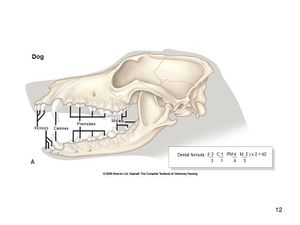Difference between revisions of "Dental Formula - Dog"
Fiorecastro (talk | contribs) |
|||
| (16 intermediate revisions by 4 users not shown) | |||
| Line 3: | Line 3: | ||
[[Image:Aspinall Slide12.JPG|thumb|right|300px|<small>Image from [http://www.elsevierhealth.co.uk/veterinary-nursing/spe-60136/ Aspinall, The Complete Textbook of Veterinary Nursing], Elsevier Health Sciences, ''All rights reserved''</small>]] | [[Image:Aspinall Slide12.JPG|thumb|right|300px|<small>Image from [http://www.elsevierhealth.co.uk/veterinary-nursing/spe-60136/ Aspinall, The Complete Textbook of Veterinary Nursing], Elsevier Health Sciences, ''All rights reserved''</small>]] | ||
| − | Dogs are toothless at birth. | + | Dogs are toothless at birth. Their '''deciduous''' teeth are complete and functional within 2 months of birth in most breeds. '''Permanent''' teeth are complete and funtional by the end of the 7th month. |
| − | + | The formula for '''deciduous''' teeth: 2 (i3/3 c1/1 p3/3) | |
| − | + | The formula for '''permanent''' teeth: 2 (I3/3 C1/1 P4/4 M2/3) | |
| − | === | + | ===Canine teeth=== |
| − | + | ||
| + | The canine teeth are large, curved and laterally compressed. Their [[Enamel Organ#Root|root]] is longer than their [[Enamel Organ#Crown|crown]]. They have a single [[Enamel Organ#Root|root]]. | ||
| − | |||
| − | |||
| − | |||
| − | |||
===Molars=== | ===Molars=== | ||
| − | |||
| − | == | + | The molars are broader than the premolars. The large flat surface is used for grinding. |
| + | ===Incisors=== | ||
| − | + | The incisors are '''tricuspid''' in the upper jaw and '''bicuspid''' in lower jaw. They have a single [[Enamel Organ#Root|root]]. | |
| − | + | ===Premolars=== | |
| − | |||
| − | |||
| − | |||
| + | The premolars are irregular and closely-spaced. They are more complex and larger caudally. | ||
| − | + | ==Breed Differences== | |
| − | |||
| − | {{ | + | Eruption times differ between breeds so it is difficult to age dogs by their teeth. |
| − | + | {{OpenPages}} | |
| − | |||
[[Category:Teeth - Anatomy & Physiology]] | [[Category:Teeth - Anatomy & Physiology]] | ||
[[Category:Dog - Alimentary System]] | [[Category:Dog - Alimentary System]] | ||
| − | [[Category: | + | [[Category:A&P Done]] |
| − | [[Category: | + | [[Category:LisaM reviewing]] |
| − | [[Category: | + | [[Category:Dental Anatomy - Small Animal]] |
Revision as of 16:19, 20 September 2013
Overview

Dogs are toothless at birth. Their deciduous teeth are complete and functional within 2 months of birth in most breeds. Permanent teeth are complete and funtional by the end of the 7th month.
The formula for deciduous teeth: 2 (i3/3 c1/1 p3/3)
The formula for permanent teeth: 2 (I3/3 C1/1 P4/4 M2/3)
Canine teeth
The canine teeth are large, curved and laterally compressed. Their root is longer than their crown. They have a single root.
Molars
The molars are broader than the premolars. The large flat surface is used for grinding.
Incisors
The incisors are tricuspid in the upper jaw and bicuspid in lower jaw. They have a single root.
Premolars
The premolars are irregular and closely-spaced. They are more complex and larger caudally.
Breed Differences
Eruption times differ between breeds so it is difficult to age dogs by their teeth.
Error in widget FBRecommend: unable to write file /var/www/wikivet.net/extensions/Widgets/compiled_templates/wrt6957825531b7c9_42056186 Error in widget google+: unable to write file /var/www/wikivet.net/extensions/Widgets/compiled_templates/wrt695782553646b1_45175324 Error in widget TwitterTweet: unable to write file /var/www/wikivet.net/extensions/Widgets/compiled_templates/wrt695782553b8702_36030681
|
| WikiVet® Introduction - Help WikiVet - Report a Problem |